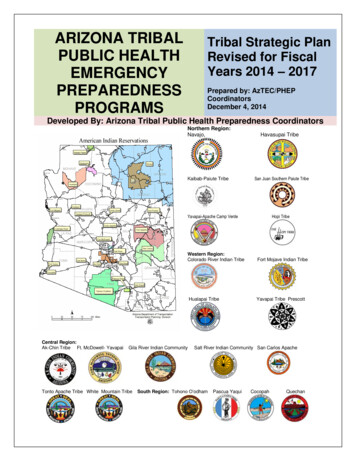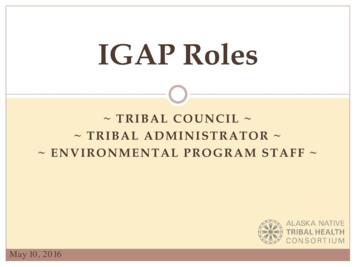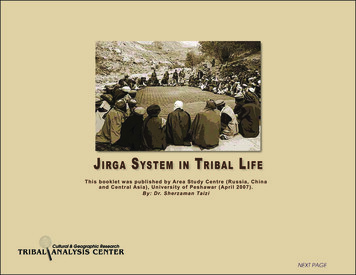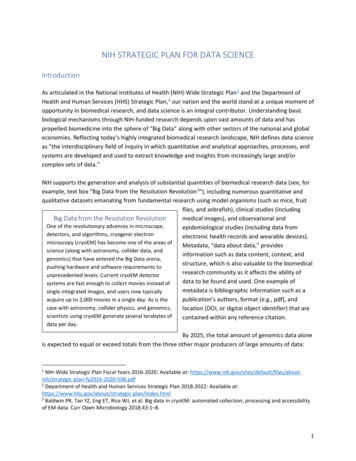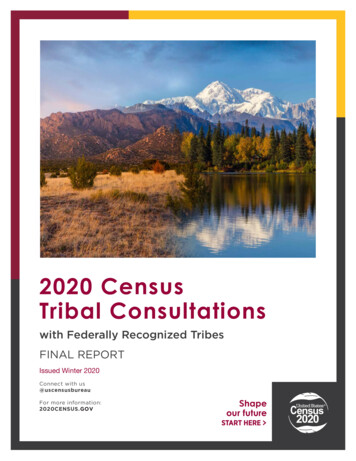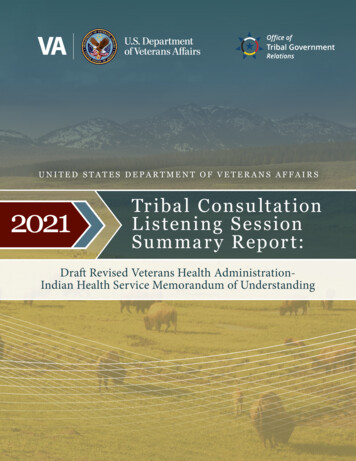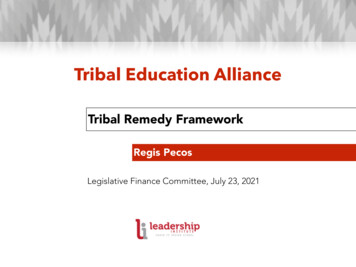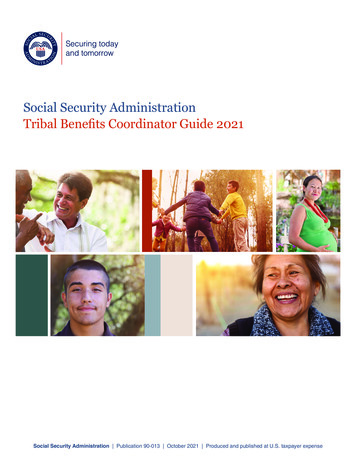
Transcription
NIH Strategic Plan for Tribal Health Research FY 2019–20231
NIH Strategic Plan for TribalHealth ResearchFY 2019–2023The purpose of the NIH Strategic Plan for Tribal HealthResearch FY 2019–2023 is to improve the NationalInstitutes of Health’s relationship and collaborativeefforts with American Indian/Alaska Native communitiesby enhancing communication and collaboration, buildingresearch capacity, expanding research, and enhancingcultural competency and community engagement.NIH Strategic Plan for Tribal Health Research FY 2019–2023i
ForewordThe Tribal Health Research Office (THRO), established in 2015, hasreached a milestone that will have a significant impact on biomedicalresearch with American Indian and Alaska Native communitiesthrough the publication of the NIH Strategic Plan for Tribal HealthResearch for FY 2019–2023. A trans-NIH effort, the Strategic Plansets the groundwork to further strengthen relationships between theNIH and American Indian and Alaska Native communities to promotehealth research. Foundations to enhance engagement throughactive collaboration and communication are critical in developingaccess to new innovations, research capacity building, and workforcedevelopment through student and faculty training.The THRO’s role in overseeing the implementation and evaluation ofthe elements of the Strategic Plan will contribute to the overarchinggoals of the agency to support biomedical research that will improvethe health of the nation. The Strategic Plan also is an excellent platform for increasingawareness about American Indian and Alaska Native health research opportunities withinour intramural and extramural communities.Many have contributed to the development of the Strategic Plan, and I extend my sincereappreciation for all of their efforts in articulating the strategic priorities.I invite you to explore the THRO website1 for information and updates. I look forward tocontinuing to build stronger research partnerships between the American Indian andAlaska Native communities and the NIH.Francis S. Collins, M.D., Ph.D.Director, National Institutes of HealthiiNIH Strategic Plan for Tribal Health Research FY 2019–2023
THRO Director’s MessageA unique government-to-government relationship exists betweenIndian Tribes and the federal government. This relationship is groundedin the U.S. Constitution and in numerous treaties, statutes, federalcase law, regulations, and executive orders that establish and definea trust relationship with American Indian and Alaska Native Tribes.This relationship is derived from the political and legal relationshipthat American Indian and Alaska Native Tribes have with the federalgovernment and is not based on race. Currently, there are 573 federallyrecognized tribes across the United States, each having its own language,customs, traditions, and health needs.The U.S. Department of Health and Human Services’ (HHS) TribalConsultation Policy (TCP) was created to strengthen the government-togovernment relations with Native communities to improve the health of Tribal nations. The TribalHealth Research Office (THRO) was established in 2015 to ensure the effective implementation2of the HHS Tribal Consultation Policy3 by coordinating Tribal health research-related activitiesacross the National Institutes of Health (NIH) and serving as the NIH point of contact for Triballeaders and communities.The THRO is pleased to announce the launch of the first NIH Strategic Plan for Tribal HealthResearch for FY 2019–2023. The Strategic Plan marks a milestone for the NIH in that itestablishes a roadmap for the agency to address health research needs for American Indian andAlaska Native communities.The strategic objectives are predicated on effective communication and collaboration throughmeaningful engagement with American Indian and Alaska Native communities and leaders.This Strategic Plan will rely on effective partnerships with community researchers, federalpartners, and other stakeholders to successfully meet each objective. A key outcome from thesepartnerships is the ability to identify metrics for use in monitoring and evaluating the progressof research endeavors while enhancing the scope, research capacity, and training of the healthresearchers. This is an important step toward improving the health and health-related outcomesof Native communities and is a fundamental principle in NIH’s mission to enhance health,lengthen life, and reduce illness and disability, and to improve the health of the nation.As Director of the THRO, I want to acknowledge the American Indian and Alaska Nativecommunities that have engaged with the THRO and provided valuable insight and contributionsto help shape and direct the office’s initiatives. The National Institute on Minority Health andHealth Disparities (NIMHD) plays a critical role in addressing the needs of underrepresentedcommunities and is a valuable partner to the THRO. We will continue to rely on the NIMHD for itsexpertise in many areas that are important to American Indian and Alaska Native communities.Additionally, I want to thank the representatives from across the NIH Institutes, Centers, andOffices (ICOs), especially members of the NIH Tribal Health Research Coordinating Committee(THRCC) and THRO staff, for their efforts in finalizing this Strategic Plan.Thank you all.Sincerely,Dave Wilson, Ph.D.Director, Tribal Health Research OfficeNIH Strategic Plan for Tribal Health Research FY 2019–2023iii
Table of ContentsPurpose of the NIH Strategic Plan for Tribal Health Research FY 2019–2023. iForeword.iiTHRO Director’s Message. iiiNational Institutes of Health.1Tribal Health Research Office.1THRO Mission Statement. 2NIH Strategic Plan for Tribal Health Research. 2Strategic Goals. 5Strategic Goal 1: Enhancing Communication and Collaboration.6Strategic Goal 2: Building Research Capacity for American Indian andAlaska Native Communities . 8Strategic Goal 3: Expanding Research. 10Strategic Goal 4: Enhancing Cultural Competency andCommunity Engagement. 12The Path Forward: Developing the Strategic Plan.14ivNIH Strategic Plan for Tribal Health Research FY 2019–2023
National Institutes of HealthThe National Institutes of Health (NIH), within the U.S. Department of Health and HumanServices (HHS), is the nation’s biomedical research agency—making and supporting vital, lifesaving discoveries and improvements to the health of the nation. The mission of the NIH is toseek fundamental knowledge about the nature and behavior of living systems and apply thatknowledge to enhance health, lengthen life, and reduce illness and disability. The NIH, throughits Institutes, Centers, and Offices (ICOs), aims to improve its relationship with American Indianand Alaska Native communities by supporting indigenous health research.Tribal Health Research OfficeIn December 2010, the HHS issued a Tribal Consultation Policy (TCP),4 which states that beforeany HHS action is taken that will significantly affect Indian Tribes, consultation with IndianTribes will occur to the extent practicable and permitted by law. The policy calls on each HHSOperating and Staff Division to have an accountable process ensuring meaningful and timelyinput by Indian Tribes in the development of policies that have Tribal implications. In 2014,the NIH released the NIH Guidance on the Implementation of the HHS Tribal ConsultationPolicy5 to facilitate the implementation of the TCP by the ICOs. For purposes of the NIH TCPimplementation guidance, the term “Indian” will be used to refer to Indian Tribes as definedin the United States Code Title 25*, and the Tribal leadership that represents them. A keyrecommendation from the implementation guidance was the establishment of the Tribal HealthResearch Office (THRO).6 In 2015, the THRO was created in recognition of the importanceof ensuring meaningful input from and collaboration with Tribal nations on NIH programsand policies in accordance with the 2010 HHS TCP. The THRO is positioned in the Division ofProgram Coordination, Planning, and Strategic Initiatives (DPCPSI) in the NIH Office of theDirector (OD).* 25 U.S.C. § 479a1 (1994).NIH Strategic Plan for Tribal Health Research FY 2019–20231
THRO Mission StatementThe THRO’s mission is to support the development of culturally relevant biomedical andhealth research vital to improving American Indian and Alaska Native health. In addition,the THRO aims to build trust in the relationships and facilitate further collaboration amongAmerican Indian and Alaska Native communities and the NIH ICOs through research effortsthat are acceptable and useful to American Indian and Alaska Native communities. Toaccomplish this, the THRO— Supports, plans, coordinates, reviews, and evaluates American Indian and AlaskaNative health research and activities Facilitates collaborative input from federally recognized Tribal communities and Tribalorganizations to relevant NIH policies and activities Supports enhancing American Indian and Alaska Native community capacity toinnovate in health research Promotes and supports the training of a diverse research workforce to reduce thehealth disparities in American Indian and Alaska Native populations.NIH Strategic Plan for Tribal HealthResearchThe NIH is committed to building a strong, coordinated community of American Indianand Alaska Native researchers and expanding scientific knowledge to improve the healthof American Indian and Alaska Native communities. To guide the NIH in accomplishing itsmission, the NIH Strategic Plan for Tribal Health Research includes a comprehensive set ofstrategic goals and objectives. The Strategic Plan focuses on enhancing communication andcollaboration, building health research capacity for Tribal communities and organizations,evaluating progress, and expanding research while simultaneously enhancing culturalcompetency and community engagement.To establish priorities and guide trans-NIH activities, the THRO developed the first Trans-NIHStrategic Plan for Tribal Health Research FY 2019–2023. This document solidifies the THRO’scommitment to enhance the NIH’s relationship with American Indian and Alaska Nativecommunities.The THRO will play a key role in facilitating and collaborating with the ICOs to meet thegoals and objectives of the NIH Strategic Plan for Tribal Health Research FY 2019–2023.The THRO will continue to serve as a primary educational resource on Tribal relations forthe ICOs, and to support the ICOs in establishing communication and initial engagementstrategies to aid in meeting the strategic objectives.2NIH Strategic Plan for Tribal Health Research FY 2019–2023
How Does the NIH Strategic Plan for Tribal Health Research SupportNIH’s Vision for Biomedical Research?The NIH Strategic Plan for Tribal Health Research FY 2019–2023 describes the alignment ofthe THRO’s mission and objectives with the NIH’s mission to seek fundamental knowledgeabout the nature and behavior of living systems and apply that knowledge to enhancehealth, lengthen life, and reduce illness and disability by drawing on specific connectionsto the NIH-Wide Strategic Plan, FY 2016–2020. The NIH-Wide Strategic Plan, which wasdeveloped to “ensure the agency remains well positioned to capitalize on new opportunitiesfor scientific exploration and address new challenges for human health,” includes fourinterdependent objectives:OBJECTIVE 1:Advance Opportunities in Biomedical ResearchOBJECTIVE 2:Foster Innovation by Setting NIH PrioritiesOBJECTIVE 3:Enhance Scientific StewardshipOBJECTIVE 4:Excel as a Federal Science Agency by Managing for ResultsNIH OBJECTIVE 1: Advance Opportunities in Biomedical Research emphasizes areasincluding health promotion, exploring fundamental science, and developing treatments andcures. The THRO is committed to working closely with all NIH ICOs and other federal andnon-federal partners (including each HHS Operating Staff Division), and collaboratively withAmerican Indian and Alaska Native communities and organizations to advance biomedicalresearch opportunities in these areas of focus with innovative strategies to supportAmerican Indian and Alaska Native research and researchers.NIH OBJECTIVE 2: Foster Innovation by Setting NIH Priorities includes the NIH focus onsetting flexible research priorities based on the best current science to serve as an effectiveand efficient steward of public resources. To support the NIH achieving this objective, theTHRO works closely with advisory and representative bodies to gather input regularly onthe alignment of NIH health research support with the public health needs of AmericanIndian and Alaska Native communities and Tribes. To measure and enhance the transparencyof this support for American Indian and Alaska Native health research, the THRO leveragesNIH portfolio analysis tools to conduct and publish regular and detailed funding analyses.NIH OBJECTIVE 3: Enhance Scientific Stewardship emphasizes the foundational principlesof rigor, reproducibility, and innovation in research. Supporting the development andretention of an outstanding health and biomedical research workforce plays a central role inthe NIH Strategic Plan for Tribal Health Research. The THRO works collaboratively with theNIH Strategic Plan for Tribal Health Research FY 2019–20233
NIH ICOs, extramural researchers, academic institutions, and Tribal communities to increaseparticipation of American Indian and Alaska Native biomedical researchers in the scientificworkforce.NIH OBJECTIVE 4: Excel as a Federal Science Agency by Managing for Results reflectsthe imperative that the NIH maintain public trust and serve as an efficient and effectivesteward of public resources. The Trans-NIH Strategic Plan for Tribal Health Research outlinesTHRO activities that support consistent and meaningful engagement with American Indianand Alaska Native representatives and communities to continuously evaluate the true valueof health research initiatives, methodologies, administration, and review processes.The THRO also prioritizes activities and support for research to develop evidence-basedinterventions to reduce disparities, including the influence of sex and gender on healthand disease in alignment with the NIH’s commitment to women’s health. The THRO isuniquely positioned to address the social determinants of health, disease, and disability;disproportionate disease risk; and opportunities for progress in prevention as crucial factorsin the development of prevention strategies and treatment interventions in areas withdisparities in health outcomes across sex and gender.4NIH Strategic Plan for Tribal Health Research FY 2019–2023
Strategic GoalsCommunicationandCollaborationCultural Competency andCommunity EngagementBuilding ResearchCapacityExpandingResearchTo address the scientific priorities and broader NIH mission in American Indian andAlaska Native health research, the NIH is aligning its collaborative activities with fourstrategic goals. The THRO, along with the NIH ICOs, developed processes and metricsfor evaluating progress on the strategic objectives and their supporting action itemsto achieve these goals. These processes and metrics—designed with the support andguidance of the Tribal Health Research Coordinating Committee (THRCC), a trans-NIHcommittee composed of representatives from the NIH ICOs—will support improvingoverall program efficiency and effectiveness; building a strong, coordinated communityof American Indian and Alaska Native researchers; and expanding scientific knowledgeto improve the health of American Indian and Alaska Native communities.In December 2018, the THRO presented the final FY 2019–2023 Strategic Plan to the NIHleadership for review and approval. The Plan was released to the public in 2019.NIH Strategic Plan for Tribal Health Research FY 2019–20235
Strategic Goal 1:Enhancing Communication and CollaborationEnhancing communication and collaboration is vital to building relationships based on trustand integrity. The NIH seeks to promote and strengthen communication and collaborationbetween the NIH and American Indian and Alaska Native communities, as well as among itsICOs, on native health research and discoveries. The goal is to develop a strong, coordinatedcommunity of American Indian and Alaska Native researchers and expand scientificknowledge to improve the health of American Indian and Alaska Native communities, as wellas to develop research that will be accepted by and useful to these communities.Strategic Objectives:1.1 Increase bidirectional communication and coordination among the NIH, Tribalnations, American Indian and Alaska Native researchers, American Indian andAlaska Native-serving organizations, and agency partners.1.2 Enhance NIH Tribal Advisory Committee (TAC) input to NIH policies andactivities related to American Indian and Alaska Native health.1.3 Enhance internal trans-NIH communication to consolidate and coordinateinformation about American Indian and Alaska Native health needs and ICOs’research, interests, and activities.1.4 Improve trans-NIH communication with the scientific community aboutAmerican Indian and Alaska Native health research, health disparities, and relatedICOs’ research and activities.Strategies:Communication Coordinate in-person meetings either at program research sites or in communities whenpossible. Communicate and coordinate via the THRO website, THRCC SharePoint, publications, sitevisits, collaborative documents, and speaking engagements. Create a group email list to disseminate American Indian and Alaska Native-relatedfunding announcements, publications, and other important information for AmericanIndian and Alaska Native health research. Create a central resource for all NIH American Indian and Alaska Native communitieswith information on NIH ICOs’ American Indian and Alaska Native research activities anddisseminate the information via the THRO webpage. Develop a biannual newsletter and distribute it via the THRO’s social media outlets. Continuously develop and deploy communication strategies to improve access andenhance the efficiency and effectiveness of social media platforms, including social mediaanalytics.6NIH Strategic Plan for Tribal Health Research FY 2019–2023
Collaboration Establish THRO social media accounts (e.g., Facebook, Twitter, YouTube) to disseminateinformation, create new partnerships, and strengthen existing ones. Conduct outreach to and solicit input from external American Indian and Alaska Nativeresearch and American Indian and Alaska Native-serving organizations, for example,the American Indian Science and Engineering Society (AISES), the Society for theAdvancement of Chicanos and Native Americans in Science (SACNAS), National IndianHealth Board (NIHB), the Native Research Network (NRN), the Association of AmericanIndian Physicians (AAIP), the National Congress of American Indians (NCAI), and theNational Council of Urban Indian Health (NCUIH). Host biannual, in-person meetings to gather input from TAC members and AmericanIndian and Alaska Native communities about NIH health research programs and policiesthat affect them.Performance Metrics1. Utilize comprehensive Web analytics to monitor activity and outreach aligned with theTHRO’s communication objectives.2. Establish and leverage a social media presence to expand outreach, develop collaborativeinitiatives, and build awareness of THRO activities.3. Convene biannual, in-person TAC meetings to facilitate conversation between TACmembers and the NIH.4. Develop collaborative partnerships with external American Indian and AlaskaNative-serving organizations to create and enhance THRO processes for effectivecommunication.Accomplishment HighlightsTribal Data Sharing and Genetics Policy Development Workshop7Albuquerque, NMAugust 30–September 1, 2017NHGRI Tribal Genetics Research Brief: American Indian and Alaska Native Communitiesand Genetics Research, March 20188The THRO/NHGRI collaboratively developed and published this genetics research guidewith input from Tribal representatives on culturally appropriate language and information.Biannual, in-person TAC meetings held regularly since September 20159In alignment with the responsibilities described in the NIH Guidance on theImplementation of the HHS Tribal Consultation Policy, the TAC has met twice yearlysince its inception in September 2015, to exchange information about NIH researchpolicies, programs, and priorities, and to discuss issues that may require government-togovernment consultation.NIH Strategic Plan for Tribal Health Research FY 2019–20237
Strategic Goal 2:Building Research Capacity for American Indian and Alaska NativeCommunitiesTo build the research capacity in American Indian and Alaska Native communities, the THROwill work with all NIH ICOs to support research that recognizes the diversity of AmericanIndian and Alaska Native Tribes, Tribal organizations, Tribal Colleges and Universities (TCUs),and American Indian and Alaska Native researchers. The THRO also will work with NIH ICOsto support research processes that respect the diversity of the communities that supportand are supported by Tribes and Tribal organizations. The THRO will work collaborativelyacross the ICOs to enhance NIH support for research priorities identified by American Indianand Alaska Native communities, recognizing and respecting that the desired outcomes ofresearch will vary among American Indian and Alaska Native communities, institutions, andorganizations. The NIH also will work to promote flexible assessment measures, identifypotential barriers and models to overcome them, and address the concept that the trainingof current and future researchers and capacity building are intertwined.The NIH recognizes the importance of supporting the increased participation of AmericanIndians and Alaska Natives in the biomedical workforce. To support the next generation ofAmerican Indian and Alaska Native researchers, the NIH will develop innovative programsand strategies to enhance scientific training opportunities across the continuum from highschool students to postdoctoral and tenure-track investigators. The NIH currently supportsregional training hubs, creating partnerships with Tribal nations and universities. The traininghubs enhance the scientific skills of high school students over two summers to prepare themfor competitive internships at the NIH. The THRO is committed to collaborating with theICOs to develop additional training programs to support and expand the training pathwayfor American Indian and Alaska Native health and biomedical researchers.Strategic Objectives:2.1Form collaborative partnerships with Tribes, communities, and research groupsto develop strategies for improving American Indian and Alaska Native healthresearch.2.2 Examine and address the varying complexity and diversity of needs for buildingresearch capacity among different American Indian and Alaska Native groups.2.3 Increase awareness of relevant NIH research support and training opportunitiesamong American Indian and Alaska Native groups.2.4 Expand support for American Indian and Alaska Native researchers to increasetheir capacity to secure NIH funding.2.5 Work to increase the number of American Indian and Alaska Native studentswho pursue health and biomedical research careers.2.6 Strengthen ICO understanding of how the NIH can best address the healthresearch priorities of American Indian and Alaska Native communities.2.7 Engage ICO collaborators to expand NIH capacity to support new and existingresearch with American Indian and Alaska Native communities and groups.Strategies:Building Capacity Support the establishment and dissemination of information on internship programs andmentorship opportunities for American Indian and Alaska Native researchers to intendedaudiences. Establish programs that will provide individual and institutional support for research,including targeted grantsmanship training programs.8NIH Strategic Plan for Tribal Health Research FY 2019–2023
Develop a comprehensive Institutional Review Board (IRB) guidance resource, includinga list of Tribal IRBs, IRB training opportunities, and additional information on AmericanIndian and Alaska Native health research and IRBs.Collaborative Partnerships Evaluate information on Tribes and how it applies to conducting research. Using information gained from direct engagement with Tribes, develop and expand onthe “Points to Consider” document designed for NIH reviewers assessing applicationsfocused on AI/AN populations. Engage the THRCC to support ICO collaboration directly with American Indian andAlaska Native communities with interests in ICO-related grant topics. Utilize widely attended events, including Tribal Consultations, to form direct connectionswith American Indian and Alaska Native communities.Performance Metrics1. Leverage NIH analysis platforms to measure and identify gaps in support for the healthresearch capacity of Tribes, Tribal organizations, and TCUs.2. Engage the TAC to collaboratively develop strategies for addressing health researchcapacity needs in different American Indian and Alaska Native communities.3. Collaborate with ICO partners involved in American Indian and Alaska Native communityengagement and health research capacity building with American Indian and AlaskaNative communities.4. Enhance external partnerships with American Indian and Alaska Native-servingorganizations and academic institutions and Tribal entities.Accomplishment HighlightsNIH presentations at the AISES 2018 National Conference, Oklahoma City, Oklahoma,October 4–6, 201810Tribal Health Research OfficeOffice of Intramural Training and Education (OITE)Office of Scientific Workforce Diversity (SWD)Sexual & Gender Minority Research Office (SGMRO)2018 NIH/IHS/SAMHSA Tribal Consultation on Opioids11On May 21 and 22, 2018, the NIH collaborated with the Indian Health Service (IHS) andthe Substance Abuse and Mental Health Services Administration (SAMHSA) to hold thefirst tri-operating division Tribal Consultation/Listening Session on the opioid epidemicin Indian country. The 2-day session included a number of presentations from federaland Tribal partners on national and Tribally specific trends in substance-related healthoutcomes, analyses of the social determinants of health impacting behavioral healthoutcomes, new research on addiction science, and upcoming funding opportunities.NIH Request for Information (RFI): Soliciting Additional Input to the NIH 2018 TribalConsultation on the Opioid Crisis in Indian Country12On January 25, 2019, the NIH issued an RFI to solicit additional input from itsstakeholders, including members of the scientific, Tribal, advocacy, and patientcommunities; basic, clinical, and translational scientists; as well as other interestedmembers of the public.NIH Strategic Plan for Tribal Health Research FY 2019–20239
Strategic Goal 3:Expanding ResearchTo further advance research in American Indian and Alaska Native communities, the THROwill work with all NIH ICOs to recognize the historical background, unique challenges, andneed to enhance existing opportunities and create new ones. For these changes to becomprehensive, meaningful, and sustainable, bidirectional engagement with American Indianand Alaska Native communities is imperative. Cultural and contextual nuances must beconsidered to maintain integrity and strengthen the THRO/NIH relationship with the Tribes.Strategic Objectives:3.1Facilitate the increase of American Indian and Alaska Native health andbiomedical research-focused applications.3.2 Support ICO identification of existing research gaps and health disparities,and the development of evidence-based, innovative strategies to address them.3.3 Support the development of training opportunities across the NIH ICOs forAmerican Indians and Alaska Natives in the biomedical research workforce.3.4 Collaborate with ICO partners to increase research opportunities throughfunding opportunity announcements (FOAs), with input from RFI solicitationsfor American Indian and Alaska Native researchers and American Indian andAlaska Native-focused projects.3.5 Support the increase of health and biomedical research grant applicationsfrom American Indian and Alaska Native health and biomedical researchers andfor American Indian and Alaska Native-focused health research.Strategies:Internal Partnerships Align THRCC, TAC, and Tribal Consultations with existing research and American Indianand Alaska Native community needs. Support increasing funding mechanisms that strengthen NIH networks with AmericanIndian and Alaska Native communities, including administrative supplements to supportearly stage American Indian and Alaska Native researchers.External Collaboration Increase awareness of FOAs
, and the Tribal leadership that represents them. A key recommendation from the implementation guidance was the establishment of the Tribal Health Research Office (THRO). 6. In 2015, the THRO was created in recognition of the importance of ensuring meaningful input from and collaboration with Tribal nations on NIH programs
